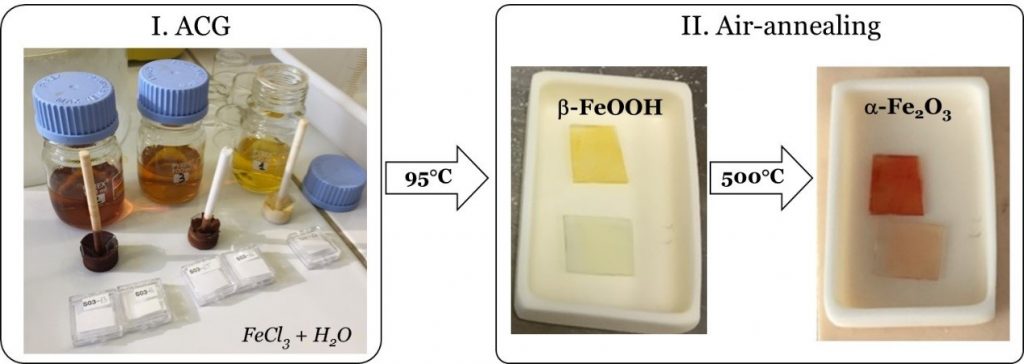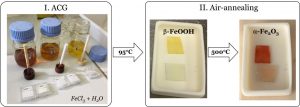The aqueous chemical growth (ACG) allows growing well-organized nanostructured oxide films with thicknesses from tens to several hundreds of nanometers. For hematite deposition the substrates (e.g. FTO on glass substrates) are dipped in aqueous FeCl3 acidic solution contained in closed bottles. The hydrothermal growth activation is achieved at temperatures lower than 100°C, the substrate being covered by an iron oxy-hydroxide film, the akaganeite phase. Film morphology, thickness, crystallographic and electronic structures, chemical composition are strongly dependent of deposition parameters: solution pH, deposition time, oven temperature, substrate cleaning, etc. Phase transition to hematite (α – Fe2O3) phase is obtained by air annealing at 500 – 600°C.

References:
- Scanning transmission X-ray spectromicroscopy: a nanotool to probe hematite nanorods for solar water splitting, Stefan Stanescu, Dana Stanescu, Adam Hitchcock
- preprint March 2023
https://chemrxiv.org/engage/chemrxiv/articledetails/640de8d7b5d5dbe9e825c049;
-
- Journal of Electron Spectroscopy and Related Phenomena 265 (2023) 147334,
https://doi.org/10.1016/j.elspec.2023.147334
- Enhancement of the Solar Water Splitting Efficiency Mediated by Surface Segregation in Ti-doped Hematite Nanorods, Stanescu S, Alun T, Dappe YJ, Ihiawakrim D, Ersen O, Stanescu D.
- preprint February 2023
https://chemrxiv.org/engage/chemrxiv/article-details/643c03bc73c6563f14fae441
-
- ACS Appl. Mater. Interfaces 2023, 15, 26593,
https://doi.org/10.1021/acsami.3c02131
- Characterizing surface states in hematite nanorod photoanodes, both beneficial and detrimental to solar water splitting efficiency, Dana Stanescu, Mekan Piriyev, Victoria Villard, Cristian Mocuta, Adrien Besson, Dris Ihiawakrim, Ovidiu Ersen, Jocelyne Leroy, Sorin G. Chiuzbaian, Adam P. Hitchcock, Stefan Stanescu, J. Mater. Chem. A, 2020, 8, 20513-20530,
https://doi.org/10.1039/D0TA06524B; hal-02934466
Contact CEA : Dana Stanescu from SPEC/LNO.




